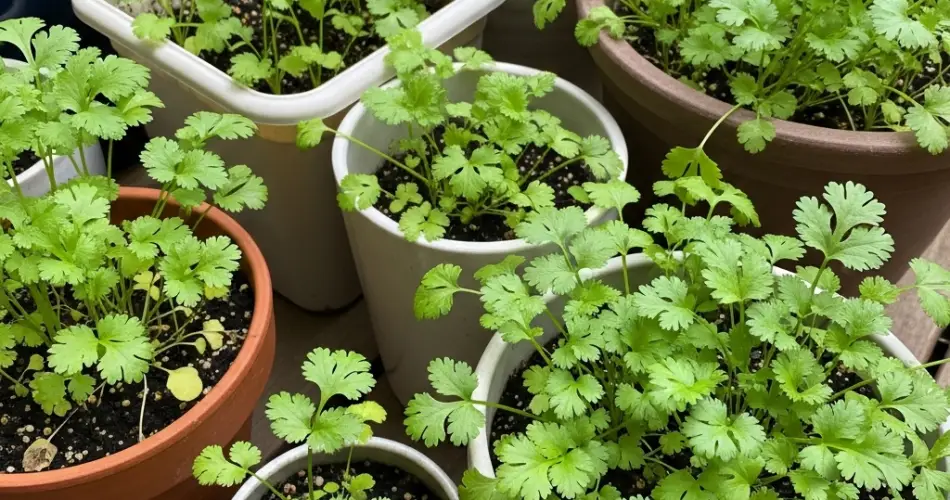Cilantro, also known as coriander in many parts of the world, is a fresh, citrusy herb that adds a bright, zesty note to countless dishes—from salsa and guacamole to curries and soups. One of the best things about cilantro is how easy it is to grow at home, especially in containers. Even if you don’t have a backyard or garden space, you can still enjoy a steady supply of fresh, flavorful leaves just by planting cilantro in pots.
This guide covers everything you need to know to successfully grow cilantro in containers—from choosing the right pot and soil to harvesting your herb at the perfect time. Whether you’re a beginner or a seasoned home gardener, cilantro is a rewarding addition to any herb garden.
Why Grow Cilantro in Containers?
Cilantro is fast-growing but sensitive to temperature changes. Growing it in containers gives you more control over the plant’s environment. You can move the pot to a shadier spot during hot afternoons or bring it indoors to extend the growing season.
Container growing also:
-
Keeps cilantro’s roots from getting compacted in dense garden soil
-
Makes harvesting more convenient—right outside your kitchen door
-
Prevents competition from weeds or nearby plants
-
Allows multiple sowings in staggered pots for continuous harvest
Choosing the Right Container
Cilantro has a taproot and does best in deep containers. Choose a pot that is at least 8–10 inches deep and 12 inches wide. A wider pot will give the plant enough space to grow without crowding.
Ensure the container has good drainage holes. Cilantro dislikes soggy roots, so drainage is key. You can use traditional terra cotta pots, plastic planters, fabric grow bags, or even upcycled items like buckets—just make sure they allow excess water to escape.
Best Soil for Cilantro
Cilantro prefers light, well-draining soil with good fertility. Use a high-quality potting mix that contains organic matter like compost or coconut coir.
For best results, you can blend:
-
2 parts potting mix
-
1 part compost
-
A handful of perlite or coarse sand to improve drainage
Avoid heavy garden soil or mixes that retain too much water, as cilantro roots can rot in poorly drained conditions.
Planting Cilantro
Cilantro grows best from seed. It doesn’t transplant well because of its long taproot, so direct sowing into the container is the most effective method.
How to Plant:
-
Fill the container with your prepared soil mix.
-
Sprinkle seeds evenly across the surface, spacing them about 2 inches apart.
-
Cover lightly with about ¼ inch of soil.
-
Water gently to moisten the soil without washing away the seeds.
-
Place the pot in a sunny spot where it gets at least 4–6 hours of light daily.
Seeds usually germinate within 7–10 days. Once the seedlings reach 2 inches tall, thin them to allow 4–6 inches of space between plants.
Light and Temperature
Cilantro grows best in cooler weather, ideally between 50°F and 75°F (10°C to 24°C). It prefers full sun but can tolerate light shade, especially in hot climates.
If you’re growing cilantro indoors, place it near a sunny window that gets at least 4 hours of direct sunlight. During summer, consider moving your pot to a location with morning sun and afternoon shade to prevent bolting (premature flowering).
Watering and Feeding
Keep the soil consistently moist but not soggy. Cilantro doesn’t like to dry out, but overwatering can lead to root problems. Water when the top inch of soil feels dry.
Feed your cilantro plant with a diluted liquid fertilizer every 3–4 weeks, or top-dress with compost if the plant starts looking pale or weak. Avoid overfeeding, as this can lead to lush leaves with less flavor.
Pruning and Harvesting
Start harvesting cilantro once the plant reaches about 6 inches in height. Use clean scissors or your fingers to snip off outer leaves, leaving the inner ones to continue growing.
For ongoing harvests:
-
Cut leaves regularly to prevent the plant from flowering early
-
Remove any flower stalks as soon as they appear to delay bolting
-
Succession sow every 2–3 weeks for a steady supply of fresh cilantro
Cilantro is known for its short life cycle, so repeated sowings are key for a continuous harvest throughout the growing season.
Saving Seeds (Coriander)
If your plant does go to seed, don’t toss it out. The seeds of the cilantro plant are coriander, a flavorful spice used in pickling, curry powders, and spice blends.
To collect coriander seeds:
-
Let the plant flower and dry out
-
Once the seed heads turn brown, cut and hang them upside down in a paper bag
-
Shake the seeds loose when dry and store them in an airtight container
Common Issues and How to Fix Them
-
Bolting: Happens when temperatures rise or plants are stressed. Provide afternoon shade and harvest leaves frequently.
-
Yellowing Leaves: Usually a sign of overwatering or poor soil drainage.
-
Leggy Growth: Occurs when the plant doesn’t get enough sunlight—move to a sunnier spot.
-
Pests: Cilantro is relatively pest-resistant but may attract aphids or caterpillars. Use a gentle water spray or natural insecticidal soap.
Final Thoughts
Growing cilantro in containers is a simple and satisfying way to add fresh, vibrant flavor to your meals. With the right container, soil, and care, this quick-growing herb will flourish on a balcony, patio, or sunny windowsill.
Whether you enjoy the leaves as cilantro or harvest the seeds as coriander, this dual-purpose plant rewards your efforts in more ways than one. For best results, sow in succession and enjoy the taste of homegrown herbs all season long.



